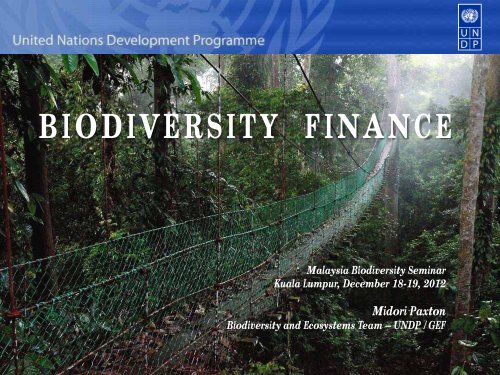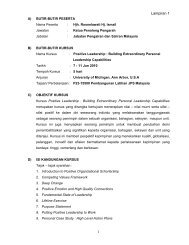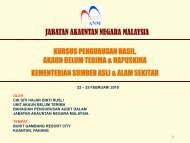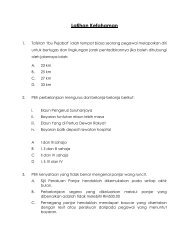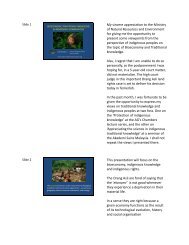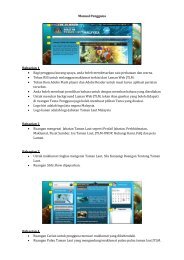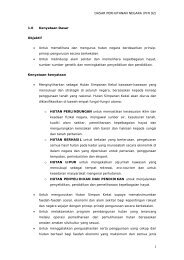BIODIVERSITY FINANCE - NRE
BIODIVERSITY FINANCE - NRE
BIODIVERSITY FINANCE - NRE
Create successful ePaper yourself
Turn your PDF publications into a flip-book with our unique Google optimized e-Paper software.
<strong>BIODIVERSITY</strong> <strong>FINANCE</strong><br />
Malaysia Biodiversity Seminar<br />
Kuala Lumpur, December 18-19, 2012<br />
Midori Paxton<br />
Biodiversity and Ecosystems Team – UNDP /GEF<br />
0
Outline<br />
1. CBD policy background on biodiversity finance<br />
2. UNDP-EC Supported Biodiversity Financing Project<br />
• Biodiversity Financing Problem Tree<br />
• Four Solutions<br />
1 1
1. CBD policy background on biodiversity finance<br />
COP-9 2008 – Strategy for Resource Mobilisation (SRM - Decision IX/11B):<br />
8 Goals, incl. exploring 6 types of (comprehensive) new and innovative<br />
financial mechanisms<br />
COP-10 2010 Package: ABS Nagoya Protocol (X/1), CBD SP 2011-2020 (X/2)<br />
Review SRM (X/3A) with 15 indicators<br />
COP-10 2010 CBD SP 2011-2020 (X/2) with Aichi Target 20:<br />
COP 11 decision XI/4. Review of Implementation of the Strategy for<br />
Resource Mobilization, including the establishment of targets<br />
Preliminary reporting framework (15 indicators) and<br />
methodological and implementation guidance<br />
CBD<br />
2
15 INDICATORS<br />
1. Aggregated financial flows – 9 categories<br />
2. No. of countries that have: a) assessed BD values; b) identified and reported funding need,<br />
gaps and priorities; c) developed national financial plans for BD; and d) been provided with<br />
necessary funding and capacity building.<br />
3. Amount of domestic financial support per annum<br />
4. Amount of funding provide through GEF and allocated to BD focal area<br />
5. Level of CBD and Parties’ support other financial institutions.<br />
6. No. of international financing institutions, UN organisations, funds, programmes and<br />
development agencies with biodiversity policy.<br />
7. No. of Parties that integrate considerations on BD and ES in development plans, strategies<br />
and budgets<br />
8. No. of South-South cooperation initiatives<br />
9. Amount and no . Of S-S and N-S technical cooperation and CB initiatives supporting BD<br />
10. No. of global initiatives for BD financing<br />
11. Amount of financial resources from all sources from developed to developing countries for<br />
achieving the Convention’s objectives<br />
12. And for implementation of the Strategic Plan for Biodiversity 2011-2020<br />
13. Resources mobilised from the removal, reform or phase-out of incentives, including subsidies<br />
harmful to biodiversity , which could be used for the promotion of positive incentives<br />
14. No. of initiatives and respective amount from new and innovative financial mechanisms – ABS<br />
15. No. of ABS initiatives and mechanisms, consistent with the Nagoya Protocol<br />
3
Global Picture: Baseline finance flows – Where it is delivered?<br />
Little Biodiversity Finance Book 2012: US$ 52 billion in 2010<br />
Needs – US$ 290 billion per year?<br />
78% generated<br />
59% used<br />
(19% transferred) 22% generated<br />
41% used<br />
(19% received)<br />
4
2. The UNDP-EC Project<br />
Building Transformative Policy and Financing Frameworks<br />
to Increase Investment in Biodiversity Management<br />
• Contribute to closing the global financing gap for the conservation and<br />
sustainable use of biological diversity by assisting countries in identifying,<br />
accessing, combining and sequencing sources of biodiversity funding to meet<br />
their specific needs.<br />
• EUR 6.4 million – 4m EC + 2.4m others incl. GEF (NBSAP)<br />
• 3 years from Oct. 25, 2012<br />
• Project Manager – on board during the early 2013<br />
• Pilots in 8 countries: Argentina, Ecuador, Kazakhstan, Malaysia, Seychelles, South<br />
Africa, The Philippines, Uganda – in MAL part of the NBSAP project.<br />
5
Biodiversity challenge – Problem Tree<br />
Biodiversity and ecosystem<br />
services are not adequately<br />
protected and maintained<br />
Insufficient funding for<br />
biodiversity conservation<br />
and management<br />
measures, both nationally<br />
and globally<br />
Severe impact of proximate<br />
drivers of biodiversity loss<br />
(habitat loss, overexploitation,<br />
IAS, pollution,<br />
climate change)<br />
Biodiversity is not valued by and<br />
integrated into national and sectoral<br />
planning and measures (ultimate<br />
drivers), and governance mechanisms<br />
are weak
Solutions to the biodiversity challenge 1: Valuation - making the<br />
business case for investment<br />
Biodiversity and ecosystem<br />
services are not adequately<br />
protected and maintained<br />
Insufficient funding for<br />
biodiversity conservation<br />
and management<br />
measures, both nationally<br />
and globally<br />
Severe impact of proximate<br />
drivers of biodiversity loss<br />
(habitat loss, overexploitation,<br />
IAS, pollution,<br />
climate change)<br />
Biodiversity is not valued by and<br />
integrated into national and sectoral<br />
planning and measures (ultimate<br />
drivers), and governance mechanisms<br />
are weak<br />
Comprehensive quantitative information on the values of<br />
biodiversity and ecosystem services, especially the economic value,<br />
is missing or incomplete<br />
1. VALUATION<br />
Apply economic valuation methodologies<br />
at national level to increase and<br />
disseminate the knowledge base on the<br />
economic value of biodiversity and<br />
ecosystem services
Solutions 1: Valuation - making the business case for investment<br />
Supported under the NBSAP Project<br />
How to conduct valuations most effectively and efficiently?<br />
• Target audience - government, sectors, local communities – different<br />
approaches needed<br />
• Impact on Policy and Behaviour/Practice<br />
• WAVES, TEEB<br />
• Targeted national sectoral-level economic valuations<br />
• Trade-off analyses between maximization of short-term<br />
gain/production and ES maintenance<br />
• Risks<br />
• Do economic valuations really make the case? Always on “our side”?<br />
• Risk of commodification – real or exaggerated, what safeguards?<br />
8
Solutions to the biodiversity challenge 2: Mainstreaming:<br />
reducing drivers/costs, increasing resources<br />
Biodiversity and ecosystem<br />
services are not adequately<br />
protected and maintained<br />
Insufficient funding for<br />
biodiversity conservation<br />
and management<br />
measures, both nationally<br />
and globally<br />
Severe impact of proximate<br />
drivers of biodiversity loss<br />
(habitat loss, overexploitation,<br />
IAS, pollution,<br />
climate change)<br />
Biodiversity is not valued by and<br />
integrated into national and sectoral<br />
planning and measures (ultimate<br />
drivers), and governance mechanisms<br />
are weak<br />
Comprehensive quantitative information on the values of<br />
biodiversity and ecosystem services, especially the economic value,<br />
is missing or incomplete<br />
2. MAINSTREAMING<br />
Apply methodologies at national level in<br />
order to enhance mainstreaming of<br />
biodiversity into national and sectoral<br />
planning and enhance governance<br />
1. VALUATION<br />
Apply economic valuation methodologies<br />
at national level to increase and<br />
disseminate the knowledge base on the<br />
economic value of biodiversity and<br />
ecosystem services
Solutions 2: Mainstreaming: reducing drivers/costs, increasing resources<br />
• How to mainstream most effectively and efficiently?<br />
• Build on economic valuations<br />
• Back up by legal/policy framework - fiscal reform, incentives, laws and regulations,<br />
official procedures<br />
• Target 1: Government<br />
• Biodiversity Policy - How to raise its profile?<br />
• Must target Ministry of Finance. EPU and other key ministries<br />
• National committees with relevant ministers and CSO<br />
• Ombudsman/Ombuds Committee<br />
• Target 2: Sectors<br />
• Relating BD & ES benefits to sectoral outputs and benefits, under BAU vs<br />
Sustainable Ecosystem Management scenarios<br />
• What is the cost of mainstreaming = of a paradigm change from BD-negative to BDpositive<br />
economy/development ? Trade offs? Political will.<br />
10
Solution 3: Finance gap assessments<br />
Donors not ready to give adequate/more<br />
funding for biodiversity management without<br />
proper knowledge of the funding gap<br />
Governments, especially in<br />
developing countries, lack capacity<br />
and resources to respond to<br />
biodiversity needs and monitor the<br />
activities under implementation<br />
Information lacking or<br />
insufficient on the financing<br />
gap (current expenditures,<br />
their (cost-) effectiveness, and<br />
the expenditures needed)<br />
Biodiversity and ecosystem<br />
services are not adequately<br />
protected and maintained<br />
3. <strong>FINANCE</strong> GAP<br />
Develop and test<br />
methodologies to determine<br />
the funding gap: current<br />
spending, (cost-)<br />
effectiveness, needs<br />
Insufficient funding for<br />
biodiversity conservation<br />
and management<br />
measures, both nationally<br />
and globally<br />
Severe impact of proximate<br />
drivers of biodiversity loss<br />
(habitat loss, overexploitation,<br />
IAS, pollution,<br />
climate change)<br />
Biodiversity is not valued by and<br />
integrated into national and sectoral<br />
planning and measures (ultimate<br />
drivers), and governance mechanisms<br />
are weak<br />
2. MAINSTREAMING<br />
Apply methodologies at national level in<br />
order to enhance mainstreaming of<br />
biodiversity into national and sectoral<br />
planning and enhance governance<br />
Comprehensive quantitative information on the values of<br />
biodiversity and ecosystem services, especially the economic value,<br />
is missing or incomplete<br />
1. VALUATION<br />
Apply economic valuation methodologies<br />
at national level to increase and<br />
disseminate the knowledge base on the<br />
economic value of biodiversity and<br />
ecosystem services
Finance gap assessment : What is Biodiversity Financing?<br />
CBD’s Preliminary Framework<br />
Category A : Activities where BD protection is the main purpose<br />
Category B: Activities related to policy development and administration carried<br />
out in part or entirely by environmental agencies and enables BD programme<br />
mgt<br />
Category C: Activities related to sustainable use and sustainable mgt that have<br />
co-benefits for BD<br />
Category D: Activities related to sustainable production and consumption<br />
where the responsibility lies with multiple government entities, the private sector<br />
and the general public<br />
12
Finance gap assessments: baseline flows, effectiveness, needs, gaps<br />
Aichi Targets Total 1 2 3 4 5 6 7 8 9 10 11 12 13 14 15 16 17 18 19 20<br />
1 Public awareness 16 1 1 1 1 1 1 1 1 0 2 2 0 1 0 1 0 0 1 1<br />
2 Econ val integrated<br />
3 Perv. subsidies red. 49 1 0 3 5 5 5 5 3 1 4 4 4 4 3 0 0 0 0 2<br />
4 SCP plans<br />
5 Habitat loss halved<br />
6 Sust fisheries<br />
7 Sust agri & forestry<br />
8 Pollution reduced<br />
9 IAS reduced<br />
10 CC ocean impacts<br />
11 PA/MPA coverage<br />
12 Spp. cons improv<br />
13 Maintain agrobiod<br />
14 E. S. maintained<br />
15 Ecos resilience & C<br />
16 ABS operational<br />
17 NBSAP implement<br />
A first attempt at gauging the cost reduction potential<br />
Range: 0 = no impact to 5 = very strong impact<br />
Reference<br />
• Same $$$ of investment?<br />
• Or: expand analysis using needs assessments figures?<br />
18 TK respected<br />
19 Knowl/sci/tech<br />
20 Fin Res enhanced<br />
13
Solution 4: Finance mechanisms<br />
Donors not ready to give adequate/more<br />
funding for biodiversity management without<br />
proper knowledge of the funding gap<br />
Governments, especially in<br />
developing countries, lack capacity<br />
and resources to respond to<br />
biodiversity needs and monitor the<br />
activities under implementation<br />
Information lacking or<br />
insufficient on the financing<br />
gap (current expenditures,<br />
their (cost-) effectiveness, and<br />
the expenditures needed)<br />
Biodiversity and ecosystem<br />
services are not adequately<br />
protected and maintained<br />
4. <strong>FINANCE</strong> MECHANISMS<br />
Identify, access, combine and<br />
sequence additional financing<br />
to justify and secure<br />
adequate/ increased funding<br />
by government and donors<br />
3. <strong>FINANCE</strong> GAP<br />
Develop and test<br />
methodologies to determine<br />
the funding gap: current<br />
spending, (cost-)<br />
effectiveness, needs<br />
Insufficient funding for<br />
biodiversity conservation<br />
and management<br />
measures, both nationally<br />
and globally<br />
Severe impact of proximate<br />
drivers of biodiversity loss<br />
(habitat loss, overexploitation,<br />
IAS, pollution,<br />
climate change)<br />
Biodiversity is not valued by and<br />
integrated into national and sectoral<br />
planning and measures (ultimate<br />
drivers), and governance mechanisms<br />
are weak<br />
2. MAINSTREAMING<br />
Apply methodologies at national level in<br />
order to enhance mainstreaming of<br />
biodiversity into national and sectoral<br />
planning and enhance governance<br />
Comprehensive quantitative information on the values of<br />
biodiversity and ecosystem services, especially the economic value,<br />
is missing or incomplete<br />
1. VALUATION<br />
Apply economic valuation methodologies<br />
at national level to increase and<br />
disseminate the knowledge base on the<br />
economic value of biodiversity and<br />
ecosystem services
Finance mechanisms: Financing Potential b y 2020<br />
US $<br />
billion<br />
40<br />
35<br />
30<br />
25<br />
Financing potential by 2020<br />
(2012 Little Biodiversity Finance Book)<br />
20<br />
15<br />
10<br />
Max<br />
Min<br />
5<br />
0<br />
*: adapted after: 2012 Little Biodiversity Finance Book<br />
15
The UNDP-EC BD Financing Project<br />
Components<br />
1. Integrate biodiversity and<br />
ecosystem services in sectoral and<br />
development policy, planning and<br />
budgeting<br />
2. Assess financing and governance<br />
needs for the management and<br />
conservation of biodiversity and<br />
ecosystem services<br />
2. MAINSTREAMING<br />
Apply methodologies at national level in<br />
order to enhance mainstreaming of<br />
biodiversity into national and sectoral<br />
planning and enhance governance<br />
3. <strong>FINANCE</strong> GAP<br />
Develop and test<br />
methodologies to determine<br />
the funding gap: current<br />
spending, (cost-)<br />
effectiveness, needs<br />
3. Identify, access, combine and<br />
sequence different sources of funds<br />
to meet biodiversity financing needs<br />
4. <strong>FINANCE</strong> MECHANISMS<br />
Identify, access, combine and<br />
sequence additional financing<br />
to justify and secure<br />
adequate/ increased funding<br />
by government and donors<br />
16
The UNDP-EC BD Financing Project<br />
Components<br />
Develop frameworks<br />
and methodologies<br />
1. Integrate biodiversity and<br />
ecosystem services in sectoral and<br />
development policy, planning and<br />
budgeting<br />
2. Assess financing and governance<br />
needs for the management and<br />
conservation of biodiversity and<br />
ecosystem services<br />
Globally coordinated<br />
with country input<br />
ditto<br />
Integrating and contributing to<br />
CBD Resource Mobilisation<br />
Strategy & Reporting<br />
Framework<br />
3. Identify, access, combine and<br />
sequence different sources of funds<br />
to meet biodiversity financing needs<br />
ditto<br />
17
The UNDP-EC BD Financing Project<br />
Components<br />
Develop frameworks<br />
and methodologies<br />
Test in 8 pilot<br />
countries<br />
1. Integrate biodiversity and<br />
ecosystem services in sectoral and<br />
development policy, planning and<br />
budgeting<br />
2. Assess financing and governance<br />
needs for the management and<br />
conservation of biodiversity and<br />
ecosystem services<br />
Globally coordinated<br />
with country input<br />
ditto<br />
Standardised<br />
Standardised<br />
Nested in<br />
Support to<br />
NBSAP<br />
Review<br />
(National<br />
Steering<br />
Committees)<br />
3. Identify, access, combine and<br />
sequence different sources of funds<br />
to meet biodiversity financing needs<br />
ditto<br />
Country-specific<br />
CBD<br />
18
3. The UNDP-EC Project<br />
Components<br />
Develop frameworks<br />
and methodologies<br />
Test in 8 pilot<br />
countries<br />
Refine and<br />
disseminate<br />
1. Integrate biodiversity and<br />
ecosystem services in sectoral and<br />
development policy, planning and<br />
budgeting<br />
Globally coordinated<br />
with country input<br />
Standardised<br />
Globally coordinated<br />
with country input<br />
2. Assess financing and governance<br />
needs for the management and<br />
conservation of biodiversity and<br />
ecosystem services<br />
ditto<br />
Standardised<br />
ditto<br />
3. Identify, access, combine and<br />
sequence different sources of funds<br />
to meet biodiversity financing needs<br />
ditto<br />
Country-specific<br />
ditto<br />
19
Biodiversity Public Expenditure and<br />
Institutional Review (BPEIR)<br />
Analyse how domestic/external sources of funding have<br />
been allocated and managed to date.<br />
Consistency with national priorities and BD Vision<br />
Policies: development and sectoral policies, incentives and<br />
subsidies<br />
Institutions: general planning and budgeting institutions,<br />
sectoral institutions and agencies for NR and<br />
environment, sectoral institutions making<br />
economic decisions<br />
Expenditures: positive and negative expenditures<br />
20
Thank you!<br />
21


